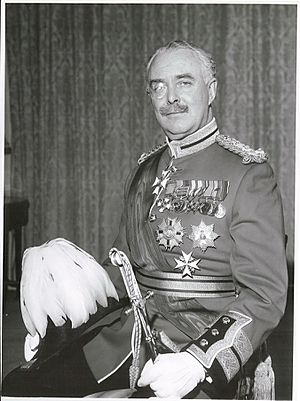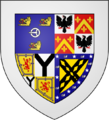Bernard Fergusson, Baron Ballantrae facts for kids
Quick facts for kids
The Lord Ballantrae
|
|
|---|---|

Fergusson in 1963
|
|
| 10th Governor-General of New Zealand | |
| In office 9 November 1962 – 20 October 1967 |
|
| Monarch | Elizabeth II |
| Prime Minister | Keith Holyoake |
| Preceded by | The Viscount Cobham |
| Succeeded by | Sir Arthur Porritt |
| Personal details | |
| Born | 6 May 1911 |
| Died | 28 November 1980 (aged 69) London, England |
| Nationality | British |
| Children | George Fergusson |
| Parent |
|
| Relatives | David Boyle, 7th Earl of Glasgow (grandfather) Sir James Fergusson (grandfather) |
| Military service | |
| Allegiance | United Kingdom |
| Branch/service | British Army |
| Years of service | 1931–1958 |
| Rank | Brigadier |
| Unit | Black Watch |
| Commands | 1st Battalion, Black Watch 16th Infantry Brigade |
| Battles/wars | Arab revolt in Palestine Second World War Palestine Emergency |
| Awards | Distinguished Service Order Officer of the Order of the British Empire Mentioned in Despatches |
Brigadier Bernard Edward Fergusson, Baron Ballantrae (6 May 1911 – 28 November 1980) was a British Army officer and a writer about history. He was the last person born in Britain to serve as the governor-general of New Zealand.
Contents
Early Life and Family Connections
Bernard Fergusson was born on May 6, 1911. He was the third son of Sir Charles Fergusson, a well-known figure. His mother was Lady Alice Mary Boyle.
Bernard came from a family with strong ties to New Zealand. Both of his grandfathers had served as governors there. His own father had also been a governor-general.
In 1950, Bernard married Laura Margaret Grenfell. They had one son, George, born in 1955. Sadly, Laura died in an accident in 1979. George later followed in his family's footsteps. He became the British High Commissioner to New Zealand. He also served as the Governor of Bermuda.
Military Career: From 1931 to 1946
Bernard Fergusson went to Eton College and then to the Royal Military College, Sandhurst. He joined the Black Watch regiment as a second lieutenant in 1931. He was promoted to lieutenant in 1934.
He served in Mandatory Palestine during the Arab revolt. He later worked as an aide to Major General Archibald Wavell. This was before the Second World War began.
In 1940, Fergusson became a brigade major. He then worked as a staff officer in the Middle East. In 1943, he was promoted to acting brigadier. He took command of the 16th Infantry Brigade. This unit became a special "Chindit" force. They operated deep in the jungles of Burma, behind enemy lines.
Fergusson led this brigade during the Chindit operations in 1944. After the war, he became the Director of Combined Operations. He ended the war as a major. He also commanded the 1st Battalion of the Black Watch.
Service in Palestine: 1946–1947
After the war, Fergusson returned to Palestine in 1946. He joined the Palestine Police Force. He commanded a special police unit called the "Police Mobile Force." This unit was made up of armed police officers. They acted as a quick response team.
Later, Fergusson suggested forming special undercover units. These units would include former soldiers. The goal was to fight against certain groups. His idea was approved, and two such units were created.
During this time, an incident occurred involving a young person. This led to an investigation. Fergusson was involved in the events surrounding this case. He was later relieved of his duties in Palestine. He then returned to Britain.
Later Military Career: 1951–1958
Fergusson continued his military career after returning to Britain. He was promoted to lieutenant colonel in 1951. He became a full colonel in 1952. He retired from the army in 1958. He held the honorary rank of brigadier.
Suez Crisis Involvement
Bernard Fergusson played a role during the Suez Crisis. This was when Britain, France, and Israel tried to take control of the Suez Canal from Egypt. Fergusson was put in charge of "psychological warfare" operations. This involved using communication to influence people's thoughts.
He planned a big campaign of messages and broadcasts. The aim was to affect Egyptian morale and public opinion. These efforts were part of the wider military operations.
Governor-General of New Zealand

In 1962, Bernard Fergusson was chosen for a very important job. He became the governor-general of New Zealand. This role represents the Queen in New Zealand. He served in this position until 1967.
After his time as governor-general, he was given a special title. He became a life peer in 1972. This meant he could sit in the House of Lords. He was known as Baron Ballantrae.
Lord Ballantrae also served as the chancellor of the University of St Andrews. He held this position from 1973 until he passed away in 1980.
Memorial Scholarship
A special scholarship was created in Bernard Fergusson's memory in 1982. It is called the Bernard Fergusson Memorial Scholarship. The Maori Queen, Dame Te Atairangikaahu, helped set it up. This was because Fergusson was a good friend to the Tainui people.
The scholarship helps students from the Tainui Tribal Confederation. It allows them to study at the University of Waikato. This helps young people who might not otherwise be able to attend university.
Because of his strong connection with the Tainui people, a primary school was named after him in 1966. It is called Ngāruawāhia Primary School. Many students from this school have gone on to receive the memorial scholarship.
Honours and Awards
Bernard Fergusson received many honours and awards for his service:
| Knight of the Order of the Thistle (KT) | 30 November 1974 | |
| Knight Grand Cross of the Order of St Michael and St George (GCMG) | 3 September 1962 | |
| Knight Grand Cross of the Royal Victorian Order (GCVO) | 11 February 1963 | |
| Companion of the Distinguished Service Order (DSO) | 5 August 1943 (Burma) | |
| Officer of the Order of the British Empire (OBE) | King's Birthday Honours, 8 June 1950 | |
| Knight of the Order of St John (KStJ) | 1961 | |
| General Service Medal | with 3 clasps | |
| 1939-1945 Star | ||
| Africa Star | ||
| Burma Star | ||
| Defence Medal | ||
| War Medal 1939–1945 | with MiD | |
| Queen Elizabeth II Coronation Medal | 1953 |
Images for kids


